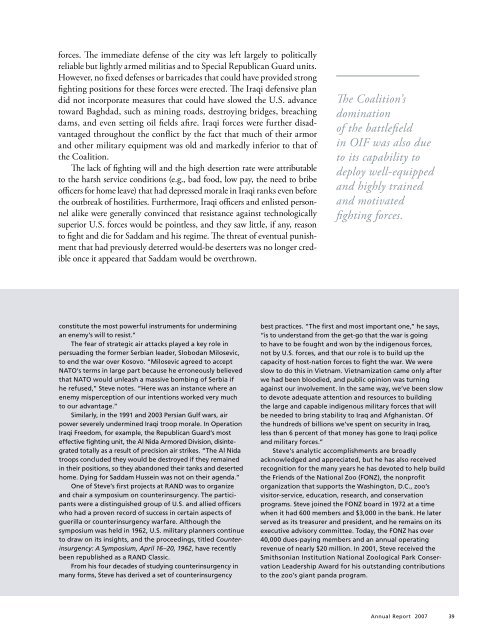RAND Project AIR FORCE Annual Report 2007 - RAND Corporation
RAND Project AIR FORCE Annual Report 2007 - RAND Corporation
RAND Project AIR FORCE Annual Report 2007 - RAND Corporation
Create successful ePaper yourself
Turn your PDF publications into a flip-book with our unique Google optimized e-Paper software.
forces. The immediate defense of the city was left largely to politicallyreliable but lightly armed militias and to Special Republican Guard units.However, no fixed defenses or barricades that could have provided strongfighting positions for these forces were erected. The Iraqi defensive plandid not incorporate measures that could have slowed the U.S. advancetoward Baghdad, such as mining roads, destroying bridges, breachingdams, and even setting oil fields afire. Iraqi forces were further disadvantagedthroughout the conflict by the fact that much of their armorand other military equipment was old and markedly inferior to that ofthe Coalition.The lack of fighting will and the high desertion rate were attributableto the harsh service conditions (e.g., bad food, low pay, the need to bribeofficers for home leave) that had depressed morale in Iraqi ranks even beforethe outbreak of hostilities. Furthermore, Iraqi officers and enlisted personnelalike were generally convinced that resistance against technologicallysuperior U.S. forces would be pointless, and they saw little, if any, reasonto fight and die for Saddam and his regime. The threat of eventual punishmentthat had previously deterred would-be deserters was no longer credibleonce it appeared that Saddam would be overthrown.The Coalition’sdominationof the battlefieldin OIF was also dueto its capability todeploy well-equippedand highly trainedand motivatedfighting forces.constitute the most powerful instruments for underminingan enemy’s will to resist.”The fear of strategic air attacks played a key role inpersuading the former Serbian leader, Slobodan Milosevic,to end the war over Kosovo. “Milosevic agreed to acceptNATO’stermsinlargepartbecauseheerroneouslybelievedthat NATO would unleash a massive bombing of Serbia ifherefused,”Stevenotes.“Herewasaninstancewhereanenemy misperception of our intentions worked very muchto our advantage.”Similarly, in the 1991 and 2003 Persian Gulf wars, airpower severely undermined Iraqi troop morale. In OperationIraqi Freedom, for example, the Republican Guard’s mosteffective fighting unit, the Al Nida Armored Division, disintegratedtotallyasaresultofprecisionairstrikes.“TheAlNidatroops concluded they would be destroyed if they remainedin their positions, so they abandoned their tanks and desertedhome.DyingforSaddamHusseinwasnotontheiragenda.”OneofSteve’sfirstprojectsat<strong>RAND</strong>wastoorganizeand chair a symposium on counterinsurgency. The participantswereadistinguishedgroupofU.S.andalliedofficerswhohadaprovenrecordofsuccessincertainaspectsofguerilla or counterinsurgency warfare. Although thesymposiumwasheldin 1962,U.S.militaryplannerscontinuetodrawonitsinsights,andtheproceedings,titledCounterinsurgency:A Symposium, April 16–20, 1962, haverecentlybeenrepublishedasa<strong>RAND</strong>Classic.From his four decades of studying counterinsurgency inmany forms, Steve has derived a set of counterinsurgencybest practices. “The first and most important one,” he says,“is to understand from the get-go that the war is goingto have to be fought and won by the indigenous forces,notbyU.S.forces,andthatourroleistobuildupthecapacityofhost-nationforcestofightthewar.Wewereslow to do this in Vietnam. Vietnamization came only afterwehadbeenbloodied,andpublicopinionwasturningagainstourinvolvement.Inthesameway,we’vebeenslowto devote adequate attention and resources to buildingthe large and capable indigenous military forces that willbeneededtobringstabilitytoIraqandAfghanistan.Ofthe hundreds of billions we’ve spent on security in Iraq,less than 6 percent of that money has gone to Iraqi policeand military forces.”Steve’s analytic accomplishments are broadlyacknowledged and appreciated, but he has also receivedrecognitionforthemanyyearshehasdevotedtohelpbuildthe Friends of the National Zoo (FONZ), the nonprofitorganization that supports the Washington, D.C., zoo’svisitor-service, education, research, and conservationprograms.StevejoinedtheFONZboardin 1972atatimewhenithad600membersand$3,000inthebank.Helaterserved as its treasurer and president, and he remains on itsexecutiveadvisorycommittee.Today,theFONZhasover40,000dues-payingmembersandanannualoperatingrevenue of nearly $20 million. In 2001, Steve received theSmithsonian Institution National Zoological Park ConservationLeadership Award for his outstanding contributionstothezoo’sgiantpandaprogram.<strong>Annual</strong> <strong>Report</strong> <strong>2007</strong> 39
















